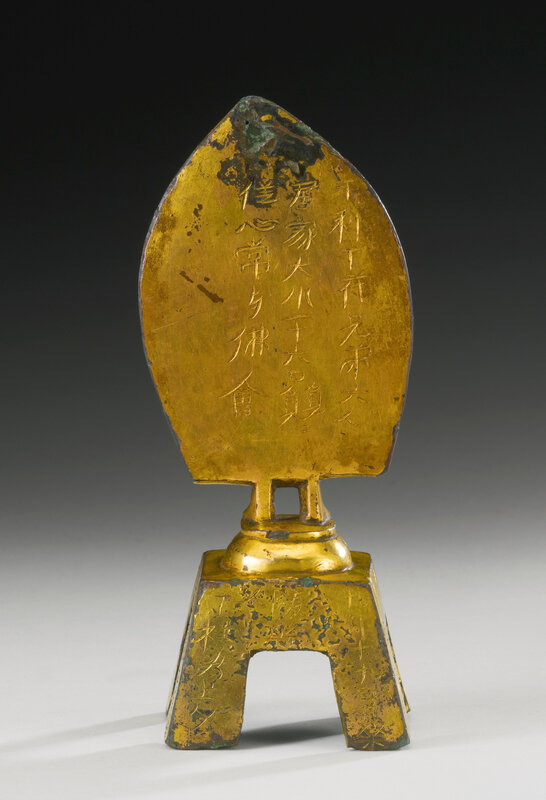An important gilt-bronze votive stele of Guanyin, Northern Wei dynasty, dated 484 AD
Lot 12. An important gilt-bronze votive stele of Guanyin, Northern Wei dynasty, dated 8th year of the reign of Taihe corresponding to 484 AD. Height 6 1/8 in., 15.6 cm. Estimate 200,000 — 300,000 USD. Lot sold 293,000 USD. © Sotheby's.
the figure cast with right hand holding a stem with large lotus bud over the shoulder, the left hand to the side holding a flask, standing on a domed base raised on a four-legged plinth, the upper body bare except for a triangular necklace, clad in a dhoti and long scarf draped over the shoulders and upper arms, the face with a pensive expression below hair swept into a chignon fronted by a three-leafed crown, framed by a circular halo of radiating lotus petals, all against an integral lotus leaf-shaped mandorla incised with two registers of flames, the back incised with a dedicatory inscription, continuing onto the sides and back of the plinth, Japanese wood box (7).
Provenance: Collection of Chen Jieqi (1813-1884) (Fig. 1).
Collection of Marquis Blasco Lanza d’Ajeta, Italian Ambassador to Japan, 1952.
Christie’s London, 26th October 1964, lot 153.
Mayuyama & Co., Ltd., Tokyo, acquired between 1960-1969.
Fig. 1.
Exhibited: Rikuchou Jidai No Kondoubutsu, Kuboso Memorial Museum of Arts, Izumi, Japan, 1991, cat. p.48, no.48.
Literature: Seigai Omura, Shina bijutsu-shi, Choso-hen, Tokyo, 1915-20, pl. 159, fig. 465, from a Lo Chen-yu rubbing.
Hugo Musterberg, ‘A Group of Chinese Buddhist Bronzes in the d’Ajeta Collection,’ Artibus Asiae, vol. XVI, no. 3, 1953, p. 195, pl. 4 (erroneously dated 490).
Nobuo Kumagaya, ‘The Gilt Bronze Padmapani dated 484’, Bijutsu Kenkyu, no. 208, January 1960, pl. V.
Saburo Matsubara, Chugoku Bukkyo Chokoku-shi Kenkyu., Tokyo, 1966, 1st ed., as no. 6 in his discussion on the Taihe era examples, pl. 41a, figs. 10, 22, pp. 5, 225, and 2nd ed., pl. 38a & b, p. 8, fig. 9.
Mayuyama, Seventy Years, Volume Two, Tokyo, 1976, pl. 107.
The figure displays characteristics closely associated with the second half of the fifth century, that may be traced back to Gandharan models, as explained by Hugo Munsterberg in ‘A Group of Chinese Buddhist Bronzes From the D’Ajeta Collection’, Artibus Asiae, op.cit., p. 193. Munsterberg notes that the Northern Wei artists were inspired by Western, Indian and Central Asian prototypes, both as regards style and iconography even though they modified these to suit their own artistic traditions and religious conceptions. While the Indian Padmapani is nearly always depicted with a lithe body, swaying hips and the head gently tilted to the side, the overall style resulting in a graceful curvilinear form, the Chinese artist has created an object of worship that is quite different. This Padmapani displays strength, with its straight stiff body, which is further enhanced by the fierce fire design found on the mandorla. Another aspect worth noting is the compact size of this piece, suggesting that it was made for ease of transportation. Early portable objects of worship were made in great numbers and became important in spreading Buddhism in China.
The style of this gilt-bronze figure is very close to a similar gilt-bronze figure from the Avery Brundage Collection and now in the Asian Art Museum of San Francisco, illustrated in Rene-Yvon Lefebvre d’Argence (ed.), Chinese, Korean and Japanese Sculpture in the Avery Brundage Collection, Tokyo, 1974, pl. 20, with an almost identical inscription. The only difference being that the abbreviation mark on the back of the present lot, is missing on the Brundage piece. The two pieces are so similar that the author of the Avery Brundage collection catalogue, ibid., p. 58, erroneously listed the publication details of the present lot rather than the one in the museum’s collection.
A number of other related dated examples are known in museums and private collections. For example, see one dated to 485 in the Seattle Art Museum, Seattle, illustrated in Mayuyama, Seventy Years, op.cit., pl. 112, together with a slightly later example, dated to 543 of the Eastern Wei period, in the Tokyo National Museum, Tokyo, pl. 117. Another gilt-bronze figure of Padmapani is included in Saburo Matsubara, Chugoku bukkyo chokoku shiron, vol. 1, Tokyo, 1995, p. 108a, dated to 464; one, a gift from P.T. Brooke Sewell to the British Museum, London, is published in W. Zwalf (ed.), Buddhism – Art and Faith, London, 1985, p. 199, pl. 294, dated to 471; and an example in the National Palace Museum, Taipei, is illustrated in Recently Acquired Gilt-Bronze Buddhist Images, Taipei, 1996, pl. 4, dated to 498.
Compare also a figure dated to 504 sold at Christie’s Hong Kong, 29th-30th October 2001, lot 503; another dated to 516, from the collections of Philippe and Adolphe Stoclet, sold in these rooms, 11th May 1965, lot 121; and a further example, dated to 523, offered in our London rooms, 14th November 2001, lot 28.
Sotheby's. Fine Chinese Ceramics & Works of Art. New York, 19 march 2013

/https%3A%2F%2Fprofilepics.canalblog.com%2Fprofilepics%2F1%2F0%2F100183.jpg)
/https%3A%2F%2Fstorage.canalblog.com%2F03%2F02%2F119589%2F96711876_o.jpg)
/https%3A%2F%2Fstorage.canalblog.com%2F11%2F31%2F119589%2F94773502_o.jpg)
/https%3A%2F%2Fstorage.canalblog.com%2F20%2F83%2F119589%2F94772815_o.jpg)
/https%3A%2F%2Fstorage.canalblog.com%2F26%2F72%2F119589%2F75604929_o.jpg)
/https%3A%2F%2Fstorage.canalblog.com%2F59%2F60%2F119589%2F26458628_o.jpg)







/image%2F1371349%2F20240423%2Fob_b6c4a6_telechargement.jpg)
/image%2F1371349%2F20240414%2Fob_fc4708_2024-nyr-22642-0956-000-a-dehua-figure.jpg)
/image%2F1371349%2F20240413%2Fob_120396_2024-nyr-22642-0941-001-an-exceptional.jpg)
/image%2F1371349%2F20240324%2Fob_0e02d1_181-1.jpg)